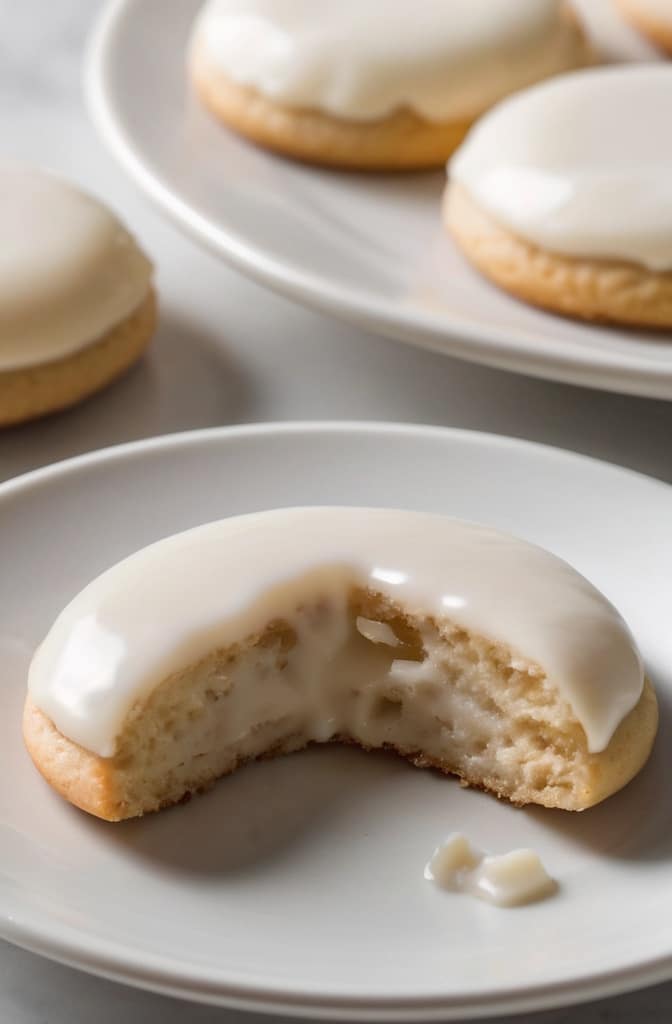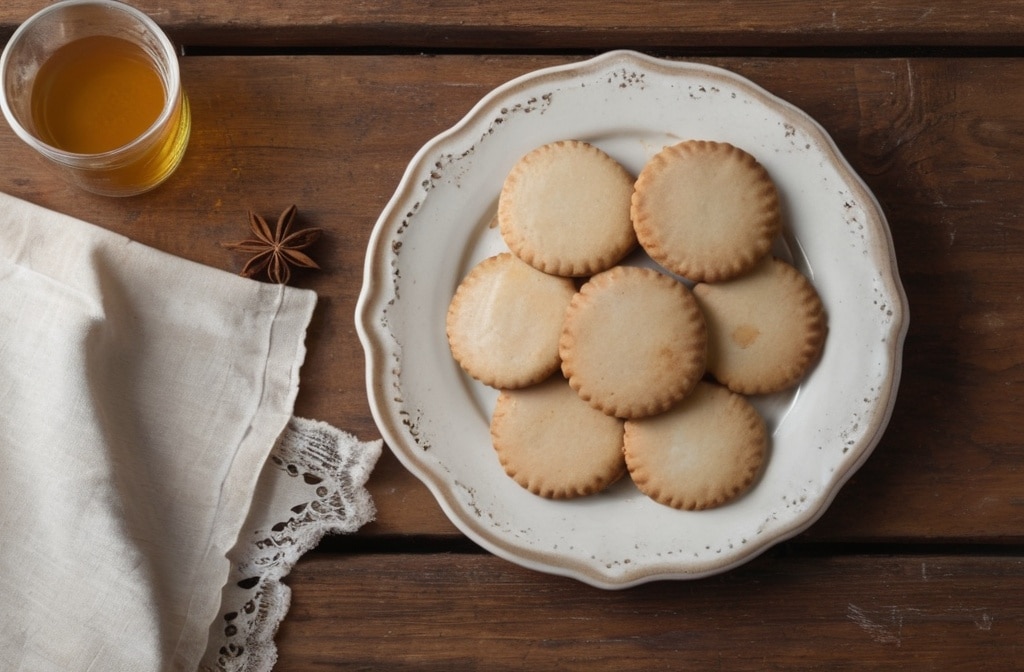Anise Cookies (Italian Anisette) remind me of my grandmother’s tiny Bronx kitchen—the clatter of tin cookie sheets, the scent of licorice flooding every corner like a wave from another century. You never forget the smell of anisette. It sticks in your clothes, your memory, your bones.
Anise Cookies (Italian Anisette) are not just cookies. They’re tiny relics of Italian-American heritage, often made during the holidays but deserving of way more year-round love. They’re soft, cake-like, and perfumed with anise extract—a flavour that either grabs you by the soul or sends you running. There’s no in-between.
Anise Cookies (Italian Anisette) stand out because of their tender crumb, stark white glaze, and sometimes, if Nonna was feeling fancy, rainbow sprinkles. The texture’s more like a cross between a muffin top and a cloud, and that’s thanks to a very specific baking method. Let’s dive in.
Ingredients & Substitutions
Anise Cookies (Italian Anisette) start with the basics, but it’s the little choices that elevate them from okay to unforgettable.
- 4 large eggs – Room temp is a must. Cold eggs mess with the batter’s emulsion.
- 1 cup granulated sugar – Fine-grain sugar is better for even dissolving.
- ½ cup neutral oil – Traditionalists use melted Crisco. I prefer sunflower or light olive oil.
- ¼ cup milk – Whole milk adds body; almond milk works in a pinch.
- 1½ teaspoons anise extract – Go pure if you can. Artificial stuff tastes like mouthwash.
- 3½ cups all-purpose flour – Spoon it into the cup, don’t scoop. Scooping = dry bricks.
- 2½ teaspoons baking powder – Freshness matters. Toss anything older than 6 months.
- ¼ teaspoon salt – Just enough to balance the sugar.
For the glaze:
- 2 cups powdered sugar
- 2–3 tablespoons milk or lemon juice
- ½ teaspoon anise extract
- Sprinkles (optional but honestly mandatory if you’re Italian-American)
Anise Cookies (Italian Anisette) tolerate some tweaks. Can’t do eggs? A mixture of aquafaba and baking soda gives some rise, though you’ll lose a bit of richness. Want a stronger cookie? Sub lemon juice for milk in the glaze. Adds tang that slices through the sweet.

Step-by-Step Instructions
Anise Cookies (Italian Anisette) are easy, but you gotta respect the process. This ain’t dump-and-go. It’s deliberate.
Step 1 – Beat the eggs and sugar. Whip ’em until pale and fluffy—like, full-on ribbon stage. This adds air and structure. Skimp here and the cookies fall flat.
Step 2 – Add oil, milk, and anise. Slowly, while beating. Not all at once like a lunatic. You’re building an emulsion. If it splits, stop and add a spoonful of flour.
Step 3 – Fold in dry ingredients. Sifted flour, baking powder, and salt go in gently. Don’t overmix. It should be sticky but not pourable—like thick pancake batter.
Step 4 – Scoop and rest. Use a small cookie scoop or two spoons. Place rounds on parchment-lined sheets. Let them sit 5–10 minutes before baking so the tops smooth out a bit.
Step 5 – Bake at 350°F for 10–12 minutes. They should puff and crack slightly but not brown. If they’re tan, you overdid it. Pull them while they still look a bit underdone; they finish as they cool.
Step 6 – Glaze while warm. Dip the tops into the glaze and place on racks to set. Add sprinkles right away—once it dries, nothing sticks.
Anise Cookies (Italian Anisette) don’t like humidity. If it’s a sticky day, cool them in front of a fan before glazing or they’ll absorb too much moisture and go gummy.
Cooking Techniques & Science
Anise Cookies (Italian Anisette) are edible chemistry experiments with sprinkles.
Anise Cookies (Italian Anisette) rely heavily on eggs for structure. There’s no butter here. That’s why whipping the eggs and sugar is so crucial. It traps air, giving lift without toughness. Too much flour and you’ve got dough balls, not cookies.
Anise Cookies (Italian Anisette) are cake-like due to the oil and milk combo. Oil coats flour proteins without forming too much gluten—softer, moister texture. Milk adds tenderness and helps with browning, though these cookies stay pale.
Anise Cookies (Italian Anisette) shine because of the anise extract. Aniseed contains anethole, which is fat-soluble and aromatic even in tiny amounts. It’s the same compound in fennel and absinthe. Fun fact: Italians have been flavouring cookies with this stuff for centuries, especially around Easter and Christmas.
Anise Cookies (Italian Anisette) benefit from resting. Even a 10-minute sit on the sheet lets the flour fully hydrate, which helps the cookies rise evenly in the oven. Skip this, and you might get volcano craters.
Anise Cookies (Italian Anisette) also use powdered sugar in the glaze because it dissolves quickly and forms a smooth, shiny coat. Don’t sub granulated—it’ll stay gritty and look like frosting from a haunted gas station.

Serving & Pairing Suggestions
Anise Cookies (Italian Anisette) beg for espresso. Not just any coffee. A bitter, hot, tiny cup that scorches your tongue a little. The sharp anise cuts through the dark roast in a way that feels like a Sunday in Naples.
Anise Cookies (Italian Anisette) also pair beautifully with a dessert wine—something like Vin Santo or even Sambuca if you’re going full Italian grandma. Serve them stacked on a white ceramic plate with a red-and-white checkered napkin. Over-the-top, yes. But also perfect.
Anise Cookies (Italian Anisette) love a holiday tray. Mix them with pizzelle, biscotti, and amaretti for contrast in texture and colour. They’re soft and sweet and stand out against all those crunchy, nutty cookies. Especially with those glitzy rainbow sprinkles twinkling under the lights.
Conclusion
Anise Cookies (Italian Anisette) are little magic bites of nostalgia wrapped in icing and anise-scented air. They’re simple to make but easy to mess up if you rush the steps or skip the details.
Anise Cookies (Italian Anisette) work best when treated like the old-world gems they are—handmade, slow-baked, and shared. Whether you love or hate anise, these cookies always spark a memory. They’re holiday cookies, but they’re also everyday reminders that flavour can be bold, weird, and wonderful.
Anise Cookies (Italian Anisette) thrive when the batter is respected, the glaze is balanced, and the environment is dry. If they’re too soft, too hard, or the flavour’s off, go back to the basics: room temp eggs, good extract, and no overmixing.
Try them once. They might just become your new tradition.
FAQs
What does anise extract taste like?
It tastes like black licorice—but more herbal and aromatic. It’s strong, floral, and a little spicy. If you’re not used to it, go easy at first. Too much and it can taste medicinal.
Can I use butter instead of oil?
You can, but expect a different texture. Butter gives you a denser, richer crumb. Oil keeps the cookies light and soft. If you swap, melt the butter first and cool it slightly before adding.
Why did my cookies turn out dry?
You probably added too much flour or overbaked them. Always spoon flour into your measuring cup—don’t scoop—and pull them out of the oven before they brown.
How long do Anise Cookies last?
Stored in an airtight container, they’ll keep for 5–6 days at room temp. You can freeze them too—just freeze before glazing, then thaw and glaze fresh.
Can I make these gluten-free?
Yes! Use a good 1:1 gluten-free flour with xanthan gum. The texture may be slightly different—less springy—but still tasty. You might need a smidge less flour than the original recipe calls for.
Want me to write another Italian cookie deep dive?

Olivia P. is a seasoned food blogger at Tastywink, sharing delicious, easy-to-follow recipes inspired by him passion for home cooking. With years of culinary blogging experience, he brings flavor, creativity, and a personal touch to every dish.
